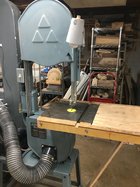Hi, not really my first bandsaw, but first one in 20 years.
I picked up a 1979 Rockwell 14" bandsaw the other day for $100. I put new wheels on ( just the rubber part not the whole wheel ) and cleaned up all the parts, put on a new blade and adjusted it. It seems to run pretty well. Doesn't have a whole lot of power from what I can tell. So I have some questions for the bandsaw owing turners out there.
a) re the power, the motor is a goo 25" away from the gear and the belt is ... idk, pretty floppy, not loose like it's slipping, just seems to have a lot of deflection. Would this effect the power? I'm not too worried about it, if I need more I can get a new motor I'm just wondering if the belt could be the problem.
b) would people say that getting a height extender is pretty important for wood turning purposes? e.g. cutting up logs so you can turn them easier.
c) what sort of blades should I order for the purposes of making jigs and cutting logs for turning? i.e. width and tooth count
d) I'm thinking of getting some of those new fangled blade guides. Either ceramic or the ball bearing type. The saw currently has the regular blocks with ball bearings behind the blade. The new systems are pretty expensive though, I wonder if they are really that important.
Thanks for the help!
I picked up a 1979 Rockwell 14" bandsaw the other day for $100. I put new wheels on ( just the rubber part not the whole wheel ) and cleaned up all the parts, put on a new blade and adjusted it. It seems to run pretty well. Doesn't have a whole lot of power from what I can tell. So I have some questions for the bandsaw owing turners out there.
a) re the power, the motor is a goo 25" away from the gear and the belt is ... idk, pretty floppy, not loose like it's slipping, just seems to have a lot of deflection. Would this effect the power? I'm not too worried about it, if I need more I can get a new motor I'm just wondering if the belt could be the problem.
b) would people say that getting a height extender is pretty important for wood turning purposes? e.g. cutting up logs so you can turn them easier.
c) what sort of blades should I order for the purposes of making jigs and cutting logs for turning? i.e. width and tooth count
d) I'm thinking of getting some of those new fangled blade guides. Either ceramic or the ball bearing type. The saw currently has the regular blocks with ball bearings behind the blade. The new systems are pretty expensive though, I wonder if they are really that important.
Thanks for the help!

